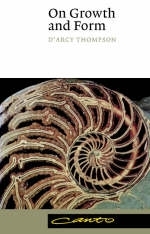
On Growth and Form
Seiten
1992
Cambridge University Press (Verlag)
978-0-521-43776-9 (ISBN)
Cambridge University Press (Verlag)
978-0-521-43776-9 (ISBN)
- Titel erscheint in neuer Auflage
- Artikel merken
D'Arcy Thompson's classic On Growth and Form looks at the way things grow and the shapes they take. Analysing biological processes in their mathematical and physical aspects, this historic work, first published in 1917, has also become renowned for the sheer poetry of its descriptions. It is now available for a wider readership including a foreword by one of today's great populisers of science.
Why do living things and physical phenomena take the form they do? D'Arcy Thompson's classic On Growth and Form looks at the way things grow and the shapes they take. Analysing biological processes in their mathematical and physical aspects, this historic work, first published in 1917, has also become renowned for the sheer poetry of its descriptions. A great scientist sensitive to the fascinations and beauty of the natural world tells of jumping fleas and slipper limpets; of buds and seeds; of bees' cells and rain drops; of the potter's thumb and the spider's web; of a film of soap and a bubble of oil; of a splash of a pebble in a pond. D'Arcy Thompson's writing, hailed as 'good literature as well as good science; a discourse on science as though it were a humanity', is now made available for a wider readership, with a foreword by one of today's great populisers of science, explaining the importance of the work for a new generation of readers.
Why do living things and physical phenomena take the form they do? D'Arcy Thompson's classic On Growth and Form looks at the way things grow and the shapes they take. Analysing biological processes in their mathematical and physical aspects, this historic work, first published in 1917, has also become renowned for the sheer poetry of its descriptions. A great scientist sensitive to the fascinations and beauty of the natural world tells of jumping fleas and slipper limpets; of buds and seeds; of bees' cells and rain drops; of the potter's thumb and the spider's web; of a film of soap and a bubble of oil; of a splash of a pebble in a pond. D'Arcy Thompson's writing, hailed as 'good literature as well as good science; a discourse on science as though it were a humanity', is now made available for a wider readership, with a foreword by one of today's great populisers of science, explaining the importance of the work for a new generation of readers.
Introduction John Tyler Bonner VII; 1. Introductory; 2. On magnitude; 3. The forms of cells; 4. The forms of tissues, of cell-aggregates; 5. On spicules and spicular skeletons; 6. The equiangular spiral; 7. The shapes of horns and of teeth or tusks; 8. On form and mechanical efficiency; 9. On the theory of transformations, or the comparison of related forms; 10. Epilogue; Index.
| Erscheint lt. Verlag | 31.7.1992 |
|---|---|
| Reihe/Serie | Canto |
| Zusatzinfo | 2 Halftones, unspecified; 181 Line drawings, unspecified |
| Verlagsort | Cambridge |
| Sprache | englisch |
| Maße | 135 x 216 mm |
| Gewicht | 442 g |
| Themenwelt | Naturwissenschaften ► Biologie ► Zellbiologie |
| ISBN-10 | 0-521-43776-8 / 0521437768 |
| ISBN-13 | 978-0-521-43776-9 / 9780521437769 |
| Zustand | Neuware |
| Haben Sie eine Frage zum Produkt? |
Mehr entdecken
aus dem Bereich
aus dem Bereich
mikroskopisch kleine Multitalente
Buch | Hardcover (2024)
Schweizerbart'sche, E. (Verlag)
29,90 €


